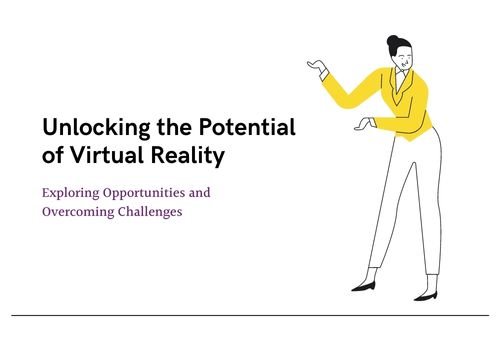Greetings, friends! Let’s explore the exciting future of virtual reality together. Virtual reality (VR) technology has made significant strides in recent years, and its potential applications continue to expand. This immersive and interactive experience has already captured the attention of many industries, from gaming and entertainment to education and healthcare. As with any new technology, however, VR faces challenges that must be addressed in order to fully realize its potential. Let’s take a look at some of the exciting possibilities that lie ahead.
Opportunities
- Gaming Industry : Firstly, in the gaming industry, virtual reality has the potential to revolutionize the way we experience games and movies. The rise of esports and online gaming has created a demand for more immersive and interactive gaming experiences. Virtual reality has the potential to revolutionize the gaming industry by providing a more realistic and engaging experience. With VR, players can immerse themselves in a virtual world, with haptic feedback and motion sensors that enhance the gameplay and make it more enjoyable. This provides a new level of interaction, allowing players to feel like they are truly part of the game world.
- Education Industry : In education, VR can offer a unique and personalized learning experience, making education more fun and accessible for students. Students can explore virtual environments that would be difficult or impossible to experience in real life, such as historical sites or scientific concepts. VR can also be used to simulate real-world scenarios, allowing students to practice and apply their skills in a safe and controlled environment. By providing a personalized and memorable learning experience, virtual reality can help students to better retain and understand information.
- Healthcare Industry : Moreover, virtual reality has incredible potential in healthcare by providing medical professionals with a safe and controlled environment to practice procedures. This reduces the risk of mistakes and improves patient outcomes. VR can also be used to treat mental health conditions such as anxiety and PTSD by providing patients with a safe and immersive environment in which to confront and overcome their fears. For example, exposure therapy can be used to treat phobias, allowing patients to face their fears in a controlled environment. VR can also be used for physical therapy, providing patients with a safe and controlled environment to practice exercises and regain mobility.
Challenges
While VR presents many opportunities, it also faces several challenges.
- Technical Limitations : One of the biggest challenges is technical limitations. The technology still has limitations in terms of resolution, field of view, and latency, which can impact the quality of the VR experience and limit its potential uses. However, this challenge is being addressed by ongoing research and development to improve the technology and make it more accessible to a wider audience. Companies are investing in improving the technology to provide a more realistic and immersive experience.
- Ethical Concerns : Another challenge facing VR is ethical concerns. As VR becomes more immersive and realistic, it raises ethical concerns about the impact of VR on human behavior. For example, there is a concern that VR could desensitize people to violence or lead to addictive behaviors. However, these concerns are being taken seriously by companies and researchers, who are creating guidelines for the responsible use of VR technology. This includes creating VR experiences that promote positive behaviors and social responsibility.
- Accessibility : Finally, we must strive to make VR more accessible for everyone. While VR hardware has become more affordable, it still requires a significant investment for most people. Additionally, VR hardware can be difficult for some people to use, such as those with disabilities or older adults. Companies are working to make VR more accessible by creating hardware that is easier to use and by developing software that is compatible with a wider range of devices. This will ensure that VR can be used by a wider audience, including those who may benefit the most from its applications in healthcare and education.
Conclusion
In conclusion, the future of virtual reality is incredibly exciting, with endless opportunities for innovation and growth. Let’s embrace this technology and work together to overcome the challenges that lie ahead. With dedication and passion, we can create a future that is filled with endless possibilities. Thank you for reading, and have a wonderful day!

